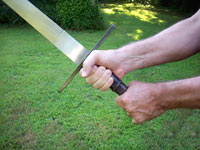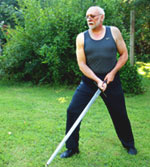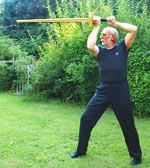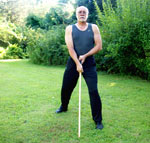|
|
Discipline of the Sword
Introduction - Dictionary of Terms - Guards - Footwork
(Please note: The following is for information purpses only. Chivalry-Now does not accept responsibility for anyone who is harmed in
the performance of these exercises.)

We
present this resource for edification and non-combative purposes only.
If you wish to actually train with the long sword, it is recommended that
you take instruction from a reputable teacher. The proper skills and safety
protocols of this martial art cannot be dispensed through online training.
Discipline
of the Sword provides photos and explanations of the basic concepts
utilized by Western medieval swordplay. It incorporates Italian and German
techniques, as well as some modern variations.
Our
purpose is to familiarize the scholar engaging in the Path to Knighthood with the art and science of this discipline. If you practice these
forms without guidance from a teacher, you should use a safe training
sword (no sharp point or edges) in an open space and with no one
nearby in the reach of your sword. You might model your solitary practice
on Tai Chi, another martial art. Never practice with a partner without
adequate safety equipment and professional supervision. You should also
make sure that you are healthy enough to perform these exercises. Check
with a doctor if you are not already certain.
Before
practicing, it is important to prepare your body for training by sufficiently
stretching and warming-up your joints and muscles, the neck, arms, legs
and back especially. It is recommended that you supplement by doing strengthening
exercises as well, such as pushups and sit-ups. Lifting weights is also
helpful. Although practical medieval swords were not very heavy, good
muscle tone and stamina contribute to good technique. What we are striving
for is the kind of knowledge, self-discipline, physical health and good
posture that contribute to one's knightly stature, the quality
known as franchise.
Examine
the photos and study the narratives to get an idea of each position's
balance and utility in detail. If you perform the postures as a form of
exercise, use a mirror and refer to the photos often to identify mistakes
and correct your form. Don't just memorize what you see. Think of actual
applications and their rationale. Use your imagination.
It
is important to gain control of the sword under the watchful eye of a qualified teacher so that it moves and stops
exactly where you want, with exactly the force that you intended. Only
constant practice will help you achieve this. Sloppy cuts and careless
footwork are unacceptable. Don't be afraid of being critical of your performance.
Self-honesty is part of the discipline process.
While
practicing the movements slowly, get a feel for balance and body dynamics
involved, which muscle groups are being used and how best to employ them.
Mobility is important. At first, practice motions that emulate strikes, thrusts
and parries in each posture without moving your feet. Let your body inform
you as a direct examination of truth. Once the motions become familiar,
add a little more speed. Begin and end the motion with precision. Stay
alive to the moment so that you can quickly change directions of techniques
at will, even by instinct. Keep relaxed yet attentive enough to respond
quickly and deliberately. Remember, a tight muscle is a slow muscle - you have to relax it before initiating the move, and that slows you
down. Instead, aim for a feeling of explosive readiness.
The
benefit of an edged sword is not having to hit with great force, so
do not overdo it. Hard hitting can strain muscles, slow reaction time,
and exaggerate motions that leave you vulnerable.
When you are ready, step
forward for cuts or thrusts, and step backward for blocks and parries.
When you feel confident with that, add more foot speed. Try different
steps and transitional footwork to sidestep and circle your imaginary
opponent, including diagonals. Your goal is freestyle mobility, sort of
like shadow-boxing.
Repetition
is important to help your muscles and nerves become accustomed to their
tasks, but do not overdo it.
As
you progress, you might want to learn the names of the stances, strikes
and other concepts in order to be conversant in this art. A dictionary
of related terms is provided. Do not let foreign vocabulary overwhelm
you. Go at your own speed. It will eventually become
familiar
Remember.
This is a limited introductory survey meant for edification purposes only.
Good swordsmanship involves much more than we show you online. If you want more,
consider joining a class on swordplay, where protective equipment and
a qualified teacher will help you progress.
Two schools of thought
The
guard positions that follow reflect the surviving treatises of two
medieval sword masters: Fiori dei Liberi, from Italy, and Johannes
Liechtenauer, from Germany. You will note differences and similarities.
We are thankful to these masters for leaving behind a survey of this
martial art heritage.
It
is a good idea to learn the names of these positions in their original
language. What you learn will eventually define you as a Knight, if that
is your goal.
Overview of Fiore dei Liberi's teaching
For pictures, see Guards
Low Guards
- Denti di Cinghale (Boar's Tooth)
- Tutta Porta di
Ferro (Complete Iron Gate)
- Mezza Porta di
Ferro (Middle Iron Gate)
- Posta di Coda Lunga Distesa (Long and Extended Tail)
Middle Guards
- Posta Breve (Short
Guard)
- Posta Lungo (Long
Guard)
- Posta Frontali or Posta Corona (Front or Crown Guard)
- Posta Bicornio (Two Horned Guard)
High Guards
- Posta Finestra (Window Guard)
- Posta di Donna (Woman's Guard)
- Posta di Donna
Sinestra (Woman's Guard Left)
- Posta di Donna
Soprana (Proud Woman's Guard)
- Posta di Falcone (Hawk Guard; Italian, but not attributed to Fiore)
Sword Strikes
- Fendente (strike
from above)
- Sotanto (strike
from below)
- Mezzane (horizontal
strike to the middle)
- Punta (thrust with
point)
- Mezza Spada (middle
sword; one hand holds hilt, the other holds the blade. For close-in
fighting and entering into traps, throws and locks.
Overview of Johannes Liechtenauer's
teaching
For
pictures, see Guards
The Guards
Primary
- Vom Tag (Vom Dach)
on
the shoulder
- Vom Tag (Vom Dach)
over the head
- Alber (Fool)
- Ochs (Ox)
- Pflug (Plow), (pronounced
flug), use thumb grip
Secondary
- Zornhut (Guard
of Wrth)
- Schrankhut (Blockade
Guard)
- Langort (Long Guard)
- Hengetort (Hanging
Guard)
- Schlussel (Guard
of the Key)
- Einhorn (Guard
of the Unicorn.
- Weshsel (Guard
of the Changer)
- Nebenhut (Close
Guard)
- Eisenport (Guard
of the Iron Door)
Methods of attack
- Oberhau (strike
from above)
- Unterhau (strike
from below)
- Mittelhau (horizontal
strike)
- Oberstich (thrust
from above)
- Stechen (stabbing)
- Unterstich (thurst
from below)
The Master Strokes
- Zornhau - wrath
cut, a simple, powerful diagonal attack or block followed by counter.
It comes from winding the body for the strike in a Zornhut stance.
- Scheitelhau - scalp
cut, aims high, directly to the top of the head. Its quick, extended
reach breaks the lower guards.
- Zwerchhau - thwart
cut. Perfromed from an Ox position, to an Ox position on the other
side in a fanning, thumb grip motion. Can block while hitting (fanning
sword when initiating guard is high); keep hilt high for protection.
- Schielhau - squinting
cut. A diagonal, pre-emptive oberhau to head or shoulder that incorporates
the thumb grip for added control. Can be applied from a sidestep, or
by striking your opponent's sword to break his line of engagement, followed
by a thrust.
- Krumphau - off-line
cut. Performed with a side-step from the Blockade Position, twisting
the crossed hands in a fan-like manner to hit your opponent's hands;
you can also side-step to hit the head; you can do the fanning
swing to block an incoming sword, and then make a small circle (using
the pummel for control) and hit up to the head with the false edge.
Miscellaneous.
Absetzen
- Blocking and stabbing
at the same time. This is accomplished by changing Pflug guards, left
to right or vice versa, to intercept a rising stroke. Thumb grip provides
the hilt control to make this work.
- Once the opponent's
attack is stopped, administer a thrust.
- It can also be
accomplished against a downward stroke by rising from the Pflug position
to that of Ochs. Angle the cross-guard accordingly.
- One can practice
this as an exercise with feet together, legs slightly bent, shifting
from one guard position to the other. Remember to include the thumb
grip for correct positioning of hilt.
Ansetzen, a sudden attack
with the point of the sword while opponent prepares to attack. As the
opponent repositions or pulls back to initiate an oberhau, hit high.
Against an unterhau preparation, hit low.
Durchlaufen,
running through, to wresting holds
Durchwechseln,
redirect from oberhau, ride under to ochs thrust. Can be used if opponent
attacks blade.
Drei Wunder, 3 methods of wounding an opponent: thrust, strike, cut (push or pull sword
in order to slice)
Hendtrucken-Schnitt,
pressing the wrists with blade
Nachreism,
chasing. Pull back from opponent's oberhau that is being used to defend
against your oberhau. Redirect strike in the same direction as your opponent's
sword.
Überlaufen,
over-running
Winden, winding
sword.
Zuken, pulling
back to avoid block and counter.

Top |
Special Features:

|




